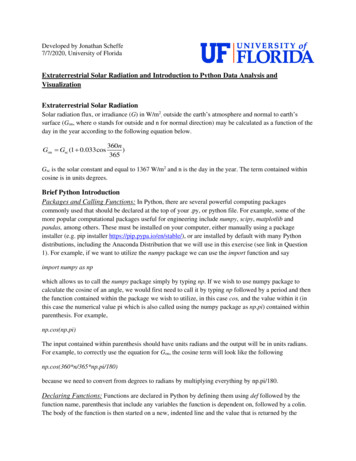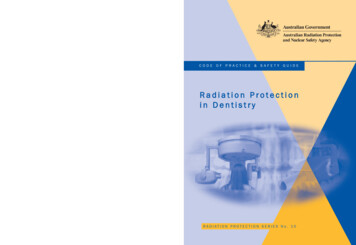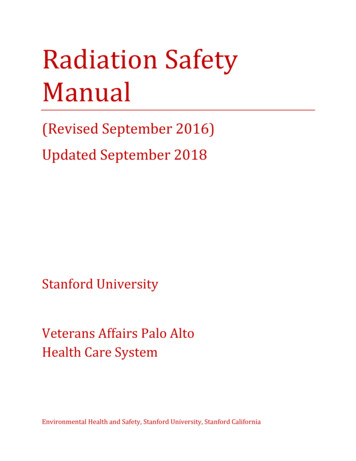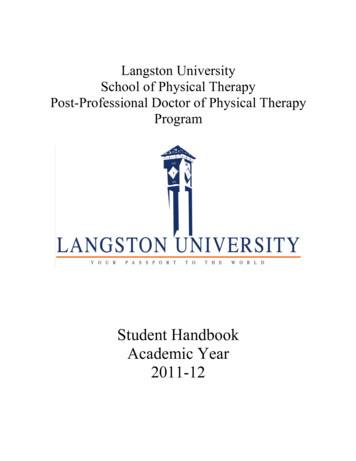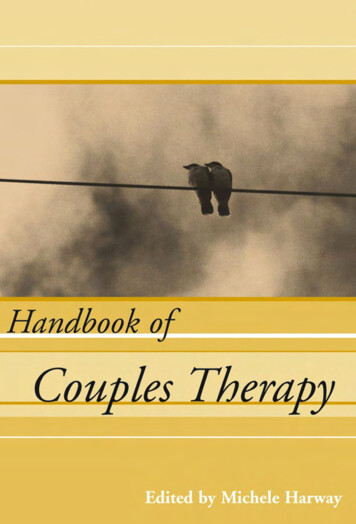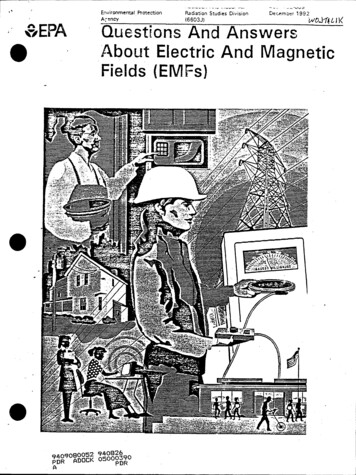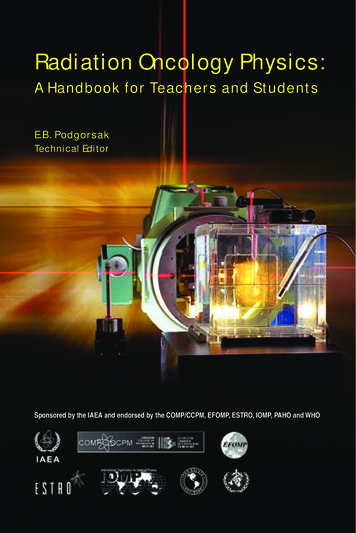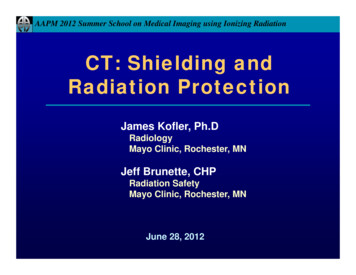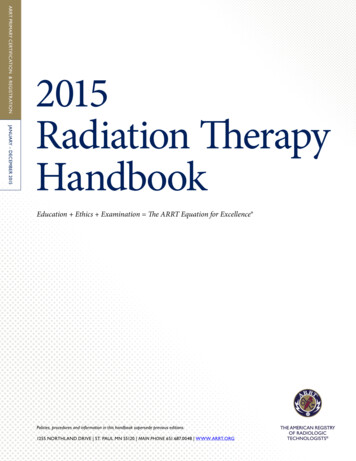
Transcription
ARRT PRIMARY CERTIFICATION & REGISTRATIONJANUARY – DECEMBER 20152015Radiation TherapyHandbookEducation Ethics Examination The ARRT Equation for Excellence Policies, procedures and information in this handbook supersede previous editions.1255 NORTHLAND DRIVE ST. PAUL MN 55120 MAIN PHONE 651.687.0048 WWW.ARRT.ORG
How to Use This HandbookInfo May Change;Check Onlinefor UpdatesThis Certification & Registration Handbook is designed to help you understand,and to apply and prepare for, the process. It is published for each calendar year, butchanges to policy or procedures may occur during the year, so be sure to checkwww.arrt.org/handbooklinks for updates.Before you apply and againbefore you take your exam, besure to check www.arrt.org/handbooklinks for any policy orprocedure changes that may occursubsequent to publication.Information in this handbook supersedes that in any prior versions. ARRT annuallyprovides handbooks that correspond to the year of potential exam date.To help you be as successful as possible, you will want to read the following informationvery carefully and save it for future reference.In these pages, you will find. Introduction and background material on ARRT and its certification andregistration programs Details on important eligibility requirements for certification and registration candidates An outline of the topics covered in the exam* Step-by-step instructions on applying for and scheduling your exam Tips on the exam format Test center requirements and procedures Information on what happens after you complete the exam Important appendices like ARRT Rules and Regulations, Standards of Ethicsand Continuing Education Requirements Sample application form and checklist* ARRT does NOT provide study materials for any certification and registrationWatch forThese Symbolsor state licensing exams.This exclamation point isyour pointer to key pieces ofinformation you need to know.TIPThis icon tips you to ways you can streamlineyour journey through the certification andregistration process and beyond.NCCA AccreditationARRT’s Radiography, Nuclear Medicine Technology, Radiation Therapy, Sonography and Registered Radiologist Assistantcertification and registration programs have earned accreditation by the National Commission for Certifying Agencies (NCCA), theaccrediting body of the Institute for Credentialing Excellence (ICE).To receive NCCA accreditation, ARRT demonstrated that this certification and registration program met strict standards inaccordance with ICE’s mission to promote excellence in competency assurance for practitioners in all occupations and professions.For more information on ICE/NCCA and their accreditation programs, visit them at www.credentialingexcellence.org.It is ARRT’s policy not to discriminate against any candidate for certification and registrationbecause of race, color, religion, creed, age, gender, national origin or ancestry.The American Registry of Radiologic Technologists 1255 Northland Drive, St. Paul, Minnesota 55120-1155Telephone 651.687.0048Visit our website at www.arrt.orgCopyright 2014 by The American Registry of Radiologic Technologists . All rights reserved.Reproduction in whole or in part is not permitted for any purpose without the written consent of the ARRT .
2015 Certification and Registration Handbook for Radiation TherapyTable of ContentsIntroducing ARRTNine Decades of History. 4Organizational Structure. 4Mission-Driven.4-5Two Categories: Primary and Post-Primary. 5Certification and RegistrationEligibility RequirementsEthics. 6Ethics Review Pre-ApplicationCheck “Ethics and the ARRT” VideoEducation. 7Degree Requirement for 2015 and Beyond3-Year Eligibility Limit for 2013 and BeyondExamination.7-8Study Materials Not Provided by ARRTUpholding Exam SecurityWhy Does Security Matter So Much?. 8Help Us Protect Exam SecurityDisclosing Exam Information. 8Candidate Agreement on Exam DisclosurePotential Disclosure Scenarios. 9Application ProceduresCheck “Applying for Certification” VideoAgreement of Candidates. 10Name Requirements. 10Form, Legal Name and IDs Must MatchPhoto Requirements. 10Six-Month Limit on Photo and SignaturesApplication Fees. 10Application Timing. 11Avoid Processing DelaysExamination Window. 11Out of Time? Extend Window or Forfeit FeeTest Centers. 11Testing Accommodations. 12Ask Up FrontCertification and Registrationvs. State-Related Licensing. 12Questions About Your State?ARRT Follow‑Up to ApplicationAcknowledgment of Receipt. 13Application Review. 13Changes to Your Eligibility StatusCandidate Status Report (CSR).13-14Verifying Education. 14Before You Pick a DateModifying Submitted InformationAddress or Name Changes. 14Extending an Exam Window.14-15Maximum of Three ExtensionsThe Exam AppointmentScheduling Your Appointment. 15Internet Scheduling; Follow-Up and Confirm (p.16)Missing Your Appointment. 16Canceling or Re-schedulingYour Appointment. 16Invalid ID? Cancel Appointment; ExceptionCalling to Re-schedule? Remember to CancelExam Administration DayTest Center Environment. 17Preview Exam Day via VideoFollow Procedures. 17Arrive Early. 17What if the Test Center is Closed?. 17Severe Weather Looming?ID, Photo, Signature, PVR. 18Palm Vein RecognitionAcceptable Forms of IDAssignment to Testing Station. 18Calculators and Notes. 19Requesting Assistance. 19Exam Timing.19-20Pace YourselfTest Center Misconduct and Score Cancellation. 20-21Taking the Exam. 21Non-Disclosure AgreementCandidate Comments. 21Leaving the Test Center. 22Appeals of Exam Administration. 22After the ExaminationCancellation of Scores. 23Score Reporting. 23Interpreting Scores.23-24How/When Will I Know I Am Certified and Registered?Appeals of Exam Scoring. 24Re-examination. 24Three-Attempt, Three-Year Limit. 24State Attempts Count Against LimitInitial Certification and Registration. 25Pins, Patches, ShieldsAnnual Renewal of Certification and Registration. 25Using “R.T.” or “ARRT” with Name?Continuing Education Requirements. 26Annual Renewal vs. CE BienniumCE Timeline for Newly Certified and Registered R.T.sCQR: Continuing QualificationsRequirements. 27Check out CQR on VideoReinstatement of Certification andRegistration by Examination. 27Re-qualification for Certification and Registration. 27APPENDICESSee page 28 for a list of appendices and page numbers.
IntroducingARRT ARRT — The AmericanRegistry of RadiologicTechnologists — promoteshigh standards of patient careby recognizing qualifiedindividuals in medical imaging,interventional proceduresand radiation therapy.Nine Decades of HistoryThe year was 1922. The Lincoln Memorial was dedicated on May 30. A first-classpostage stamp cost two cents. Insulin was the revolutionary new treatment for diabetes.And Sister M. Beatrice Merrigan took her Radiography exam on November 17. The testincluded 20 essay questions and a prescribed set of radiographs. She was notified of hercertification and registration the day after Christmas, when she earned the distinction ofbeing the country’s first Registered Technologist.We were the Registry — founded earlier that year by the Radiological Society of NorthAmerica, with support of the American Roentgen Ray Society and the American Societyof X-Ray Technicians.The Registry was incorporated in 1936 as the American Registry of X-Ray Technicians.Its board was appointed by the Radiological Society of North America and the AmericanSociety of X-Ray Technicians. By the end of the decade, there would be more than 2,400Registered Technologists.In 1944, the American College of Radiology assumed the responsibility of appointingboard members along with the American Society of Radiologic Technologists.Forty years after its founding, the Registry expanded its examination programs to includenuclear medicine technology and radiation therapy. At that time, the organization’s namechanged to The American Registry of Radiologic Technologists, a name more inclusiveof all three disciplines of certification and registration. By the end of the 1960s, ARRTwould boast a total of 56,000 certificates — some 700 in nuclear medicine technologyand nearly 300 in radiation therapy.The decade of the ‘90s saw a sweeping expansion of ARRT’s offerings. The new postprimary category was launched with certification and registration in cardiovascularinterventional technology and mammography. New disciplines were added as technologyemerged. As the millennium ended, ARRT had converted all of its exams from paperand-pencil to computer-based testing.Nine decades after its founding, more than 300,000 Registered Technologists, knownas R.T.s, attest to the success and strength of The American Registry of RadiologicTechnologists.Sister Beatrice was first. Now it’s your turn.Organizational StructureA 10-member Board of Trustees determines ARRT policies. The Board is composedof six Registered Technologists and four radiologists. Five of the R.T. trustees arenominated by the American Society of Radiologic Technologists (ASRT); the sixth isnominated from a professional membership society identified by the board based onits current needs. The radiologist trustees are nominated by the American Collegeof Radiology (ACR). Board members are selected to serve four-year terms, a newappointment or re-appointment from each group being made each year. Meetings ofthe Board of Trustees are held semi-annually. The Board is supported by a staff thatconducts the routine business of the Registry.Mission-DrivenThe mission of The American Registry of Radiologic Technologists is to promote highstandards of patient care by recognizing qualified individuals in medical imaging,interventional procedures and radiation therapy. The disciplines of interest include,but are not necessarily limited to, radiography, nuclear medicine technology, radiationClick here to return to Table of Contentspage 4 of 83
therapy, magnetic resonance imaging, sonography, mammography, computedtomography, quality management, bone densitometry, cardiac-interventional radiography,vascular-interventional radiography, cardiovascular-interventional radiography, vascularsonography and breast sonography. ARRT also offers certification and registration forradiologist assistants.In support of this mission, ARRT: adopts and upholds standards for educational preparation for entry into the profession adopts and upholds standards of professional behavior consistent with the levelof responsibility required by professional practice, and develops and administers examinations that assess the knowledge and skillsunderlying the intelligent performance of the tasks typically required by professionalpractice in the disciplineIn addition to initial recognition, ARRT operates a system of annual renewal of certificationand registration to identify individuals who continue to demonstrate their qualificationsby adhering to the standards of professional behavior and complying with continuingeducation requirements.The activities of the organization are primarily national in scope, but include internationalactivities to the extent they impact practice or standards in the U.S. or its territories.Two Categories: Primaryand Post-PrimaryPrimaryARRT provides a primary categoryof certification and registration in fivedisciplines of radiologic technology:RadiographyRadiographers apply ionizing radiationto demonstrate portions of the humanbody — on a radiograph, fluoroscopicscreen, or other imaging system — toassist physicians in diagnosis of diseaseand injury.Post-PrimaryARRT offers a post-primary category of certification and registration in mammography, computed tomography,magnetic resonance imaging, quality management, bone densitometry, cardiac-interventional radiography,vascular-interventional radiography, sonography, vascular sonography and breast sonography. ARRT also offerscertification and registration for radiologist assistants.Candidates for post-primary certification and registration must be certified and registered by ARRT (except wherenoted) in the appropriate disciplines as indicated below.Radiographyis asupportingcategory forNuclearMedicineTechnology*is a supportingcategory forRadiationTherapyis a supportingcategory forSonography**is asupportingcategory forMammography ComputedTomography Nuclear Medicine TechnologyNuclear medicine technologists useradioactive materials in specialized studiesof body organs to assist physicians indiagnosis and treatment of disease.MagneticResonanceImaging QualityManagement Radiation TherapyRadiation therapists use ionizingradiation-producing equipmentto administer therapeutic dosesof radiation as prescribed by physiciansfor treatment of disease.BoneDensitometry CardiacInterventionalRadiography VascularInterventionalRadiography Sonography VascularSonography BreastSonography ***RadiologistAssistant Magnetic Resonance ImagingMagnetic resonance imaging technologistsutilize the resonant frequency propertiesof atoms within a magnetic field to imageanatomic and/or physiologic conditionsof the body to assist physicians in thediagnosis of disease.SonographySonographers use nonionizing, highfrequency sound waves to image portionsof the human body to assist physicians inmaking diagnoses.Click here to return to Table of ContentsMagneticResonanceImagingis asupportingcategory for * Supporting category of Nuclear Medicine Technology may be through ARRT or NMTCB.** Supporting category of Sonography may be through ARRT or ARDMS.*** Certification and registration in both Radiography and Mammography as supporting categories is needed forBreast Sonography eligibility.page 5 of 83
Certification andRegistration EligibilityRequirementsEligibility includesrequirements in threeimportant areas: ethics,education and examination.EthicsTIPConcerned AboutEthics Eligibility?Request a ReviewThe Rules of Ethics are standards of minimally acceptable professional conduct forall Registered Technologists and candidates. The Rules are intended to promote theprotection, safety and comfort of patients. Registered Technologists and candidatesengaging in any of the conduct or activities noted in the Rules of Ethics, or who permit theoccurrence of such conduct or activities, have violated the Rules of Ethics and are subjectto sanctions.If you’re concerned aboutwhether your conviction recordwill affect eligibility, you can findout before even beginning aneducational program.ARRT investigates all potentialviolations to determine eligibility,which can cause delays inprocessing applications. Avoiddelay by requesting a preapplication review of the violationbefore or during your education,rather than waiting until completingthe educational program. (If youexpect to graduate within sixmonths, use the Application forCertification & Registration insteadof the pre-application form.) ARRTdetermines the violation’s impact onyour eligibility. Once you establishethics eligibility, you may proceedwith application.Download the pre-applicationpacket from www.arrt.org/handbooklinks, or request acopy by phoning ARRT at651.687.0048, ext. 8580.Learn more about eligibility in theARRT Rules and Regulations(Appendix E) and ARRTStandards of Ethics (Appendix F).TIPCheck ‘Ethics andthe ARRT’ VideoOur pledge to promote high standards of patient care includes enforcing high standardsof ethics among Registered Technologists — and among candidates for certification andregistration. All candidates must comply with the Rules of Ethics contained in the ARRTStandards of Ethics (Appendix F).One issue addressed by the Rules of Ethics is conviction of a crime — which includesmisdemeanor, gross misdemeanor or felony, the only exceptions being speeding andparking violations. All alcohol and/or drug related violations must be reported.“Conviction,” as used in this provision, includes a criminal proceeding where a finding orverdict of guilt is made or returned, but the adjudication of guilt is either withheld, deferred or not entered, or the sentence is suspended or stayed, or a criminal proceeding where the individual enters a plea of guilty or no contest(nolo contendere), or there is a pre-trial diversionYou aren’t required to report offenses that were committed as a juvenile and wereadjudicated through the juvenile court system.The Application for Certification & Registration asks: “Have you ever been convicted ofa misdemeanor, felony or a similar offense in a military court-martial?” If your answeris “No,” you move on to the next question. If you answer “Yes,” you must provide adetailed explanation and copies of official court documentation of the charges. Courtdocumentation must verify the nature of the conviction, the sentence imposed by thecourts and the current status of the sentence. If you have a court-martial, you must providea detailed personal explanation, documentation verifying the reasons for the court-martialand the conditions of and status of the sentence.Delay in disclosure to ARRT of misdemeanor or felony charges and/or convictions resultsin a minimum private reprimand in the R.T.’s ARRT file. Although private reprimands arenot publicly reported, a private reprimand is still considered to be a sanction against anindividual’s ARRT certification and registration.A second question asks whether you have had any professional license, registrationor certification subjected to any conditions or discipline by a regulatory authority orcertification board.The application also asks you to respond to a question about violations or sanctionsrelated to the honor code. All candidates must sign a written consent under the FamilyEducational Rights and Privacy Act (FERPA). This consent allows ARRT to communicatefreely and openly with program directors and to obtain specific parts of your educationalrecords concerning violations of an honor code.The “Ethics and the ARRT” videoat www.arrt.org/videos could helpanswer additional questions youmay have.Click here to return to Table of Contentspage 6 of 83
EducationDegree Requirementfor 2015 and BeyondCandidates who completetheir educational program after12/31/2014 will be subject to anassociate degree requirement.For more information, ity LimitCandidates completing aneducational program in 2013and beyond have three years toestablish eligibility.Those who completed educationalprograms by the end of 2012 havefive years to establish eligibility forARRT certification and registration.Candidates establish eligibility forARRT certification and registrationthrough the following stages:1) submitting appropriateapplication form and fee2) undergoing an ethics reviewif necessary3) completing the applicationprocess4) receiving an assignedexamination window in the formof a Candidate Status ReportIf you answer “Yes” on theapplication form to the “Haveyou.” questions, you must submitdocuments for an ethics review.ARRT cannot assign an examwindow until the ethics reviewdetermines your eligibility to takethe exam.If you require an ethics review, bearin mind that your eligibility timeframe needs to accommodate thereview. In other words, you shouldsubmit your application at theearliest possible time, so ARRT cancomplete the review and you cancomplete the application processwithin the eligibility time frame.Candidates completing educational programs January 1, 2013, and beyond will havethree years to submit applications and be determined eligible. (See sidebar at left).Candidates in radiography, nuclear medicine technology or radiation therapy, or forradiologist assistant, must have completed an educational program in that discipline.Candidates in magnetic resonance imaging or sonography must have either completedan ARRT-recognized educational program in that discipline or met the discipline’s postprimary eligibility requirements.Candidates who complete an educational program in 2015 and beyond must have earnedan associate (or more advanced) degree from an institution accredited by an agencyrecognized by ARRT. Visit www.arrt.org/handbooklinks for a list of accrediting agenciescurrently recognized by ARRT.The degree does not need to be in radiologic sciences, and it can be earned beforeentering the educational program or after graduation from the program.To verify the accreditation status of a certain program or institution, consult the appropriateaccrediting agency’s website.Information on recognition of radiologist assistant programs can also be found atwww.arrt.org/handbooklinks.Candidates for ARRT primary certification and registration must, as part of theireducational programs, demonstrate competency in didactic coursework and an ARRTspecified list of clinical procedures. (See appendix B for details.) Satisfaction of thatrequirement must be indicated by signature of your program director — and, if required,an authorized faculty member — on your application for certification and registration.ExaminationARRT designs examinations in collaboration with content experts from various specialties.The primary exams consist of questions designed to measure the knowledge andcognitive skills underlying the performance of the major tasks typically required withinthe profession.Consult the content specifications in Appendix A of this handbook for the list of topicscovered by the examination. ARRT doesn’t provide specific lists of study materialsor textbooks because the exams are built using many references. ARRT neitherrecommends nor endorses any review programs, mock registries or study guides for anyof its examinations.ARRT owns the copyright for the examinations. Law prohibits any attempt to reproduce allor part of the examinations. Anyone caught removing exam materials from the test center,whether by physical removal or by reproducing materials from memory, will be prosecutedto the full extent of the law and will have eligibility for certification and registration revoked.See the following “Upholding Exam Security” section for more information.Pilot QuestionsPilot questions are unscored questions embedded in the exam. ARRT uses data fromthese pilot questions to evaluate new exam questions. This is a cost-effective way toIf you are not determined eligiblewithin the allowable time frame,you must re-qualify as described onpage 27.Click here to return to Table of Contentspage 7 of 83
Study Materials NotProvided by ARRTARRT does not provide specificlists of study materials ortextbooks, nor does it recommendor endorse any review programs,mock registries or study guides.develop exam materials for future candidates, just as past candidates assisted in pilotingquestions for today.These questions are not identified as pilot questions, and they appear just like any otherquestion on the exam. The number of pilot questions in your exam is listed on the tableon page 19; these are unscored, and ARRT allots extra time for you to complete thesequestions. Your answers to these questions will not affect exam scores.UpholdingExam SecurityARRT takes very seriously itsresponsibility for exam security.so much so that candidates areheld responsible, too. Notupholding your end of the dealcould expose you to an ARRTethics investigation and/orlegal complaint.Help Us ProtectExam SecurityIf you know of any situations inwhich the security of ARRT exammaterials might be compromised,visit www.arrt.org/handbooklinks.Candidate Agreementon Exam DisclosureDisclosing exam information usinglanguage that is substantiallysimilar to that used in questionsand/or answers from ARRT examsis considered an attempt to subvertthe integrity of the exam when suchinformation is gained as a directresult of having been an examineeor having communicated with anexaminee. This includes (but is notlimited to) disclosures to students ineducational programs, graduates ofeducational programs, educators oranyone else involved in thepreparation of candidates to sit forthe examination. It is alsoconsidered an attempt to subvertthe integrity of the exam to receive,from an examinee, examinformation that uses language thatis substantially similar to that usedin questions and/or answers on theARRT exam, whether requested ornot, or to relay such information.Click here to return to Table of ContentsWhy Does Security Matter So Much?It’s a matter of public health.Candidates who successfully complete an examination and meet other requirements mayobtain ARRT certification and registration, which is a valuable credential in the field andrequired by certain employers. The examination is also used by many states as a basis forissuing licenses.Security is critical to ensuring that the examination is an accurate and reliable measureof the critical knowledge and cognitive skills underlying the tasks typically required forthe practice of medical imaging, interventional procedures and radiation therapy. In fact,subverting the integrity of ARRT’s exams is illegal, based on a Minnesota law that wentinto effect August 1, 2010. Candidates will find language about the law in the Agreement ofCandidates, and more information can be found by visiting www.arrt.org/handbooklinks.Ask yourself: Would you want a loved one to receive care from an individual who“passed” the ARRT exam because they got a sneak peek at questions and memorizedthe answers rather than having learned all the critical content that the questionsscientifically sample?Disclosing Exam Information: What's OK and What's NotCandidates see language in the ARRT Application for Certification & Registration and thenon-disclosure screens at the test center that clarifies what they are agreeing to complywith regarding exam security. That language is reproduced in the sidebar on page 21.Not living up to these agreements can result in ARRT sanctions up to and includingrevocation of certification and registration or determination of ineligibility. Violating theseagreements could also lead to legal action.The table on the next page presents some scenarios that illustrate the difference betweenwhat’s OK and what’s not. A video depicting the consequences of violating this policy isalso available at www.arrt.org/videos.If you have any questions about your responsibilities under ARRT’s exam disclosurepolicy, visit www.arrt.org/handbooklinks.page 8 of 83
Potential Disclosure ScenariosScenarioWhen it’s OKWhen it’s not OKBottom lineEducator asks candidates to “stopby” after the exam to “let me knowhow it went.”If the invitation and the feedbackto the educator relates to theirgeneral experience (“I thoughtthe test was not as difficult as Iexpected ”).This type of invitation from aneducator may be misinterpretedby the candidate — and thestudent may think that theeducator is asking the candidateto reveal copyrighted information.If the candidate is asked to revealARRT’s questions or their answeroptions, then he or she will needto report the educator to the ARRTEthics Committee. Theeducator should stop thecandidate immediately fromrevealing any exam content, sincedoing so may subject both thecandidate and educator to ARRT’sethics process.Candidate tells another candidate,“The test was very difficult — I feltlike I didn’t have enough time.”The candidate is simply tellinganother candidate how they feltabout the exam. This is all rightbecause the candidate is notrevealing any of ARRT’s questionsor the answer options.One candidate (or potentialcandidate) asks another candidateabout the specific questions.If ARRT’s questions or answeroptions are shared, theseindividuals may find themselvespart of an ARRT ethicsinvestigation and/or legalcomplaint.Candidate to educator: “You didn’tteach me about this que
The mission of The American Registry of Radiologic Technologists is to promote high standards of patient care by recognizing qualified individuals in medical imaging, interventional procedures and radiation therapy. The disciplines of interest include, but are not necessarily limite
